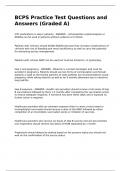Samenvatting
Samenvatting Strategy voor Pre-Master (2022)
- Instelling
- Tilburg University (UVT)
In deze samenvatting vind je de stof die behandeld is tijdens de colleges ter voorbereiding van de endterm. Met afbeeldingen vanuit de slides ter extra illustratie.
[Meer zien]













